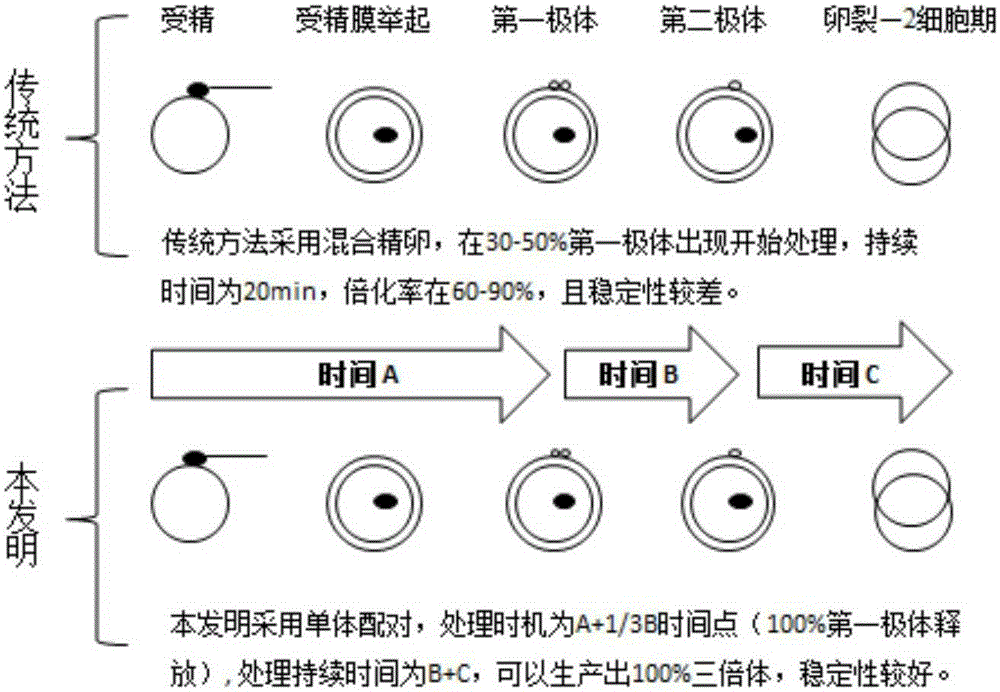A time-point quantitative processing method for the production of full triploid of Hong Kong oyster
A Hong Kong oyster and triploid technology, applied in fish farming, application, climate change adaptation, etc., can solve problems such as low induction rate and unstable doubling rate
- Summary
- Abstract
- Description
- Claims
- Application Information
AI Technical Summary
Problems solved by technology
Method used
Image
Examples
Embodiment 1
[0018] a. Acquisition of single eggs: In late June 2013, 30 mature Hong Kong oyster females aged 3-5 were selected from local Hong Kong oysters at the Zhanjiang Experimental Station of the South China Sea Institute of Oceanology, Chinese Academy of Sciences; the number and quality of eggs Selected with double indicators, and selected 6 individuals with neat development, an average number of eggs of 80 million, complete egg membranes, and dark yellow yolk accumulation as female parents; collected individual eggs, soaked in seawater with a salinity of 18ppt for 45 minutes , when the germinal vesicles are 100% completely ruptured, eggs are obtained. The eggs were washed three times with fresh seawater with a salinity of 18ppt to obtain single egg liquid, and the eggs were all round or oval.
[0019] b. Obtain single sperm: use the core population in step a as the material, screen out 12 male individuals of 2-3 years old; then test the quality of their sperm, and screen out indivi...
Embodiment 2
[0023] a. Acquisition of single eggs: In late May 2014, at the Zhanjiang Experimental Station of the South China Sea Institute of Oceanology, Chinese Academy of Sciences, 25 mature Hong Kong oyster females of 3-5 years old were selected from the Zhuhai population of Hong Kong oysters; Selected with dual indicators of quality, and selected 5 individuals with neat development, an average number of eggs of 120 million, complete egg membranes, and dark yellow yolk accumulation as female parents; collected individual eggs, and placed them in seawater with a salinity of 20ppt Soak for 30 minutes, until 100% of the germinal vesicles are completely ruptured to obtain ovum. The ovum is washed repeatedly 3 times with fresh seawater with a salinity of 20ppt to obtain single ovum liquid, and the ovum is all round or oval.
[0024] b. Obtain single sperm: use the core population in step a as the material, screen out several 10 male individuals of 2-3 years old; then test the quality of the...
Embodiment 3
[0028] a. Acquisition of single eggs: In early May 2014, 27 mature 3-5-year-old Hong Kong oyster females were selected at the Guangxi Shellfish Comprehensive Experimental Station using Hong Kong oysters from the Maowei Sea population as materials; Selected with dual quality indicators, and selected 9 individuals with neat development, an average number of eggs of 60 million, complete egg membranes, and dark yellow yolk accumulation as female parents; collect individual eggs and soak them in seawater with a salinity of 16ppt After 40 minutes, 100% of the germinal vesicles were completely ruptured to obtain eggs. The eggs were washed three times with fresh seawater with a salinity of 16ppt, and the eggs were all round or oval.
[0029] b. Obtaining single sperm: using the core population in step a as the material, select 15 male individuals of 2-3 years of age; then test the quality of their sperm, and screen out individuals with ≥30% sperm activity under the microscope , activ...
PUM
 Login to View More
Login to View More Abstract
Description
Claims
Application Information
 Login to View More
Login to View More - R&D
- Intellectual Property
- Life Sciences
- Materials
- Tech Scout
- Unparalleled Data Quality
- Higher Quality Content
- 60% Fewer Hallucinations
Browse by: Latest US Patents, China's latest patents, Technical Efficacy Thesaurus, Application Domain, Technology Topic, Popular Technical Reports.
© 2025 PatSnap. All rights reserved.Legal|Privacy policy|Modern Slavery Act Transparency Statement|Sitemap|About US| Contact US: help@patsnap.com

